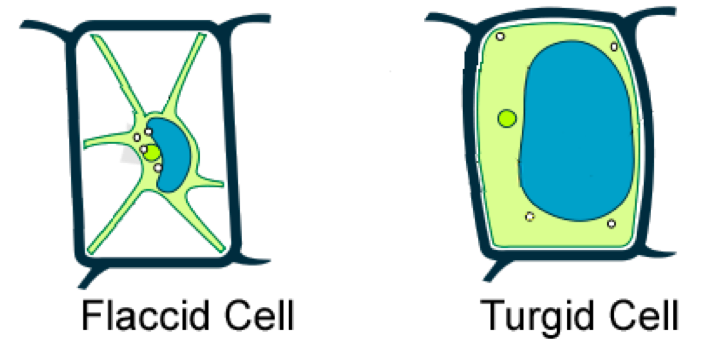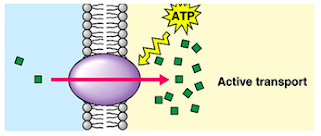Osmosis Active Transport
Osmosis
Osmosis is a specific type of diffusion. It is the movement of water from a high to low concentration through a partially permeable membrane. (Partially permeable membrane means that the membrane will only allow a certain type of substances to go through the membrane). If you have a dilute solution, then it would contain a high concentration of water molecules. On the other hand, if you have a concentrated solution, then it would contain a low concentration of water molecules. The water particles move down the “concentration gradient” and this process takes no energy (it’s a “passive” process”).
If a red blood cell is placed in water, water enters the cell by osmosis. Because the membrane is quite weak the cell will burst as the volume and therefore the pressure in the cell.
Plants absorb water from the soil by osmosis. Root hair cells are adapted for this by having a large surface area to speed up osmosis. Plants need water because… it used in photosynthesis to make its own food, it supports leaves and shoots by keeping the cells rigid It cools the leaves by evaporation, and it transports dissolved minerals around the plant.
If a plant does not have enough water, it will be flaccid - this will mean that there is low pressure inside of the cell. If a plant has too much water, it will be turgid - this will mean that there is a high pressure inside of the cell.
Active Transport
Active transport is the opposite of diffusion and osmosis as particles move from a region of low concentration to a region of high concentration. In order to transport the dissolved molecules from a region of low to high concentration, it requires energy which is released during cell respiration. Some cell membranes will have carrier proteins embedded, as it is needed to absorb the high concentration molecules from the outside of the cell, into the inside of the cell. This works against the concentration gradient.
Examples of active transport:
- In the small intestine, epithelial cells in the villi will absorb glucose.
- Plant root hair cells absorb ions from the soil water.
Key:
- Purple oval: carrier protein
- ATP: energy required to move the particles from a low to high concentration
- Green squares: substances that are moving from a region of low to high concentration
- What are the three types of transport in cells?
- Your answer should include: Diffusion / Osmosis / Active / Transport
- Which type of transport in cell requires energy (ATP)?
- Your answer should include: Active / Transport



